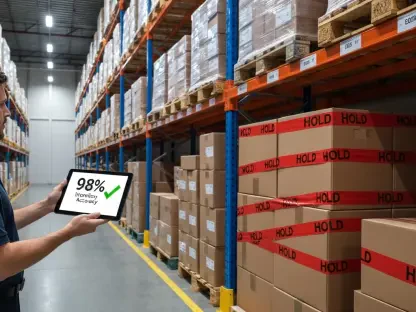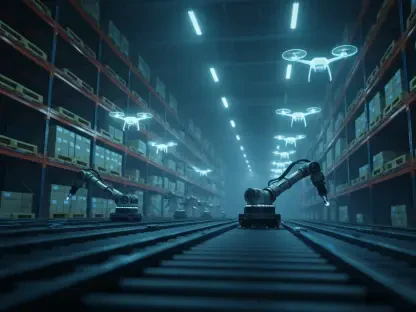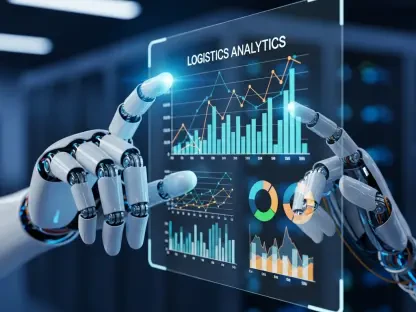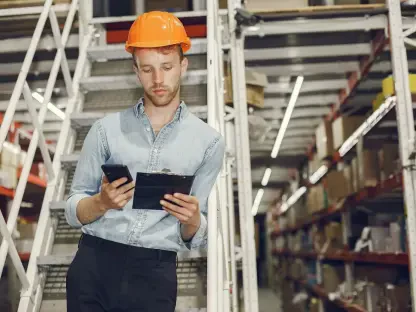The warehousing and logistics industries find themselves navigating a period of profound change spurred by both mounting operational demands and labor shortages. As the complexity of technology and the retirement of key workforce segments overlap, traditional methods can no longer sustain efficiency without significant costs. Beginning with labor shortages, compounded by the expected retirement of nearly half of Europe’s engineers within the next few years, industries are being pushed toward transformation. Simultaneously, production lines are becoming more complex due to surges in unstructured data and increasingly sophisticated machinery. As this gap widens, warehouses particularly struggle with outdated methods such as manual stock checks. These methods are inefficient, expensive, and prone to inaccuracies. Solutions are emerging through automation and human-robot collaboration to address these challenges, offering enhanced efficiency and flexibility.
Embracing Automation and AI
The response to these challenges sees businesses turning to automation and AI as transformative forces. Technologies such as autonomous drones and smart sensors have shifted inventory management dynamics. By integrating these tools, businesses can now create digital twins of warehouse environments. These virtual simulations provide real-time insights that decrease errors, lower costs, and enhance overall operational efficiency. The ability to monitor stock holistically and accurately allows companies to streamline their supply chains, addressing the inefficiencies that traditional methods perpetuate. The adoption of these digital solutions heralds an era where real-time data becomes the foundation for decision-making in warehousing. This shift is crucial, marking a transition from reactive to proactive management strategies. As warehouses evolve, embracing digital transformations ensures they remain competitive in an era where precision and adaptability are paramount.
As businesses capitalize on automation, the resulting transformation in warehouse operations becomes apparent. Technologies that once seemed futuristic are now essential to the day-to-day operations of many facilities. The real-time monitoring capabilities offered by AI enable businesses to predict stock shortages before they occur, manage inventory levels with precision, and ultimately meet customer demands more effectively. This proactive stance reduces losses and enhances the customer experience, fostering stronger relationships between service providers and clients. Moreover, by freeing human employees from rote, menial tasks, these technologies allow workers to focus on roles that capitalize on their problem-solving abilities and decision-making skills. This paradigm shift fundamentally reshapes the logistics landscape, offering a comprehensive solution to industry challenges through a combination of efficiency, accuracy, and adaptability.
The Rise of Human-Robot Teams
An integral development in this technological evolution is the emergence of hybrid human-robot teams. This concept marks a departure from Robotics 1.0, characterized by rigid, repetitive tasks with little room for adaptability. The need for flexibility in contemporary warehouse settings has driven the development of robotics that can manage diverse and dynamic environments. These intelligent systems adapt to unexpected changes, transforming robotics’ application from production lines to more intricate warehousing operations. The hybrid approach thrives on the symbiosis between human intuition and robot precision, expanding robotics’ scope beyond repetitive tasks. By conceptualizing robots as teammates rather than tools, businesses aim for a collaborative dynamic that enhances efficiency and problem-solving capabilities.
The movement towards human-robot collaboration embodies a paradigm shift, acknowledging the strengths of both workforce components. Robots excel in precision and sheer computational power, tackling tasks too monotonous or hazardous for humans, while humans bring creativity and complex decision-making ability. This synergy results in warehouse operations that are not only more efficient but also safer and more resourceful. Such collaborative environments are now vital, especially as warehousing adapts to growing demands and the need for rapid responses to unpredictable market changes. As AI and robotics technology advance, the line between human and machine roles becomes a guiding theme for future industry growth, laying the foundation for strategic partnerships that optimize the value of both.
Innovations from Sereact
Ralf Gulde, the CEO of the pioneering robotics startup Sereact, touches upon the limitations inherent in traditional Robotics 1.0 frameworks. These earlier systems were characterized by repetitive hardcoded movements primarily suited to environments like automotive manufacturing. As warehousing scales up in complexity, such rigidity proves inadequate. To address these evolving needs, Sereact has introduced the Vision Language Action Model (VLAM) technology. This advanced AI architecture empowers robots to interpret and adapt to diverse surroundings and objects. Unlike traditional methods, which require individual programming for countless items, VLAM’s adaptability reduces complexities and enhances operational flexibility. By leveraging AI’s power, Sereact’s model stands out as a pivotal innovation in warehouse robotics, urging businesses to seek solutions that accommodate the diverse landscape of modern logistics.
Gulde’s insights reflect a broader industry trend of leveraging AI to transcend the limitations of earlier robotics models. By empowering robots with the ability to adapt to new environments, VLAM eliminates the bottleneck of programming individual actions for each task. This adaptability becomes instrumental in diverse warehousing settings, where environments frequently shift, and demands vary. The shift towards understanding and interaction makes robots central to evolving business needs, fostering more resilient operations. Sereact’s innovations exemplify a practical application of AI in enabling robots to serve as autonomous agents, capable of evaluating situations and executing tasks with minimal human intervention. This technological leap redefines warehouse robotics, asserting the importance of flexibility and action-oriented intelligence in navigating the increasingly complex logistics landscape.
Digital Twins and Data Intelligence
Andrei Danescu, CEO of Dexory, highlights the transformative potential of digital twin technology. Through their DexoryView platform, this innovation is brought to life, offering real-time warehouse data insights that elevate decision-making. By automating processes once reliant on manual labor, digital twins nearly eradicate operational errors and bolster efficiency. Comprehensive multi-dimensional spatial data analysis becomes possible, revealing insights previously concealed in traditional workflows. This transition underlines the importance of data intelligence in modern logistics. The ability to visualize and analyze data dynamically boosts operational accuracy and responsiveness, thereby transforming warehousing into an environment fueled by data-driven strategies.
Dexory’s developments underscore the growing importance of data intelligence as a cornerstone of modern warehousing systems. By channeling advanced technologies like digital twins, warehouses can reimagine their operations, embracing models built on real-time insights. This approach represents a seismic shift from traditional manual processes, allowing for more nuanced, accurate decision-making. Additionally, the refined data management capabilities foster a better understanding of supply chain elements, leading to enhanced forecasting and logistical strategizing. As businesses strive to remain competitive, the integration of digital twins signifies a step toward proactive management, making it increasingly feasible to anticipate and respond to market fluctuations with agility and precision.
Integrating Human Expertise
Danescu also emphasizes the continued need for human expertise within this automated landscape. While robots provide unparalleled speed and data analysis capabilities, human workers are instrumental in bringing intuitive problem-solving and complex decision-making to the table. The fusion of human intellect with robotic efficiency creates more effective operational teams, ensuring that technology acts as an augment, not a replacement. The collaboration of man and machine therefore yields a structure where strengths complement weaknesses, fostering improved outcomes. This synergy is the foundation of the modern logistics workplace, achieving a balance that maximizes productivity and enhances team dynamics.
Fostering collaborative environments that leverage both human and robotic capabilities aligns businesses with futuristic operational goals. By shifting routine and data-heavy responsibilities to robots, human workers are left free to engage in tasks that require intricate knowledge, empathy, and adaptability. This approach not only optimizes workflows but also maintains the humane aspect that machines alone cannot replicate. The purposeful integration of human expertise within tech-centric operations establishes the warehousing sector as a domain where collaboration achieves efficiency. Encouraging this synergy fosters a workplace culture that is resilient, adaptable, and positioned for future growth. It underscores a commitment to workforce empowerment, where technology serves to enhance, not overshadow, the invaluable role of human intellect.
Addressing Unstructured Data
Maximilian Fischer, CEO of the innovative firm Deltia, addresses the challenges of handling unstructured data prevalent in manufacturing environments. Deltia’s inventive approach employs predictive analytics and data visualization technologies to unlock insights from this dispersed information, enhancing processes across various manufacturing stages. Their focus is to make data more accessible and actionable, ensuring it contributes to the efficiency and effectiveness of operations. Notably, privacy concerns become pivotal, particularly within the European regulatory landscape. Deltia tackles these issues by implementing strict measures to ensure compliance and protection, allowing companies to embrace data-driven strategies without compromising individual privacy rights.
Fischer’s contributions underscore the significance of organizing and interpreting unstructured data, which often lies dormant in manufacturing systems. Unleashing the potential of this data can lead to transformative improvements in efficiency, accuracy, and strategic decision-making. Deltia’s efforts highlight the importance of harnessing technology to create value-driven processes, where data accessibility drives innovation. The balance between data use and privacy safeguards reflects Deltia’s forward-thinking approach, addressing one of the pressing challenges in modern manufacturing. By prioritizing data-driven processes, businesses can refine their operations, optimize productivity, and make more informed decisions, crafting a path toward sustainable and measurable growth.
Tech-Savvy Workforce Trends
Bogdan Iordache of Underline Ventures highlights a notable shift in the workforce dynamic, driven by the characteristics and preferences of Generation Z. This generation, recognized for its digital proclivity, shows less interest in traditional manufacturing roles, altering the labor landscape. Their inclination towards tech-centric career paths is compounded by societal constraints on immigration, ultimately contributing to a projected shortfall of manufacturing jobs. Businesses must therefore respond by creating roles that satisfy this digital affinity, leveraging automation to fill the gap through new job opportunities. Automation emerges not only as a solution to labor shortages but as a strategy that aligns career paths with the digital era workforce’s interests.
Iordache’s analysis reflects a reality where businesses must evolve to engage a tech-savvy workforce, adapting roles to harness their digital-native skills. These shifts present a dual challenge and opportunity for the manufacturing sector to rethink workflows and integrate automation that complements the emerging job market. By aligning work environments with Gen Z’s expectations, leveraging their comfort with technology becomes a strategic advantage. The focus on automation aligns with market needs, ensuring the continuity of operational excellence amidst changing workforce demographics. As businesses strategize for the future, acknowledging these trends allows for the proactive cultivation of environments that generate engagement, creativity, and productivity, paving the way for a digitally advanced workforce.
Enhancing Human-Machine Synergy
In response to modern challenges, businesses are increasingly turning to automation and AI as transformative forces in warehouse management. Technologies such as autonomous drones and smart sensors have revolutionized inventory management by enabling the creation of digital twins—virtual replicas of warehouse environments. These simulations offer real-time insights, significantly reducing errors and costs while enhancing operational efficiency. This technological leap allows businesses to monitor inventory holistically and accurately, streamlining supply chains and addressing inefficiencies inherent in traditional methods. As a result, real-time data has become the cornerstone of decision-making in warehousing, marking a shift from reactive to proactive management strategies. This transformation is critical for businesses to remain competitive in an era where precision and adaptability are essential.
As automation takes hold, it transforms warehouse operations, making previously futuristic technologies crucial for daily tasks. AI’s real-time monitoring allows businesses to predict stock shortages, manage inventory precisely, and meet customer demands effectively, enhancing customer relationships. By automating routine tasks, employees can focus on roles that utilize problem-solving and decision-making skills.









